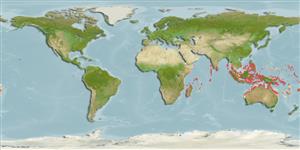Common names from other countries
>
Gobiiformes (Gobies) >
Gobiidae (Gobies) > Gobiinae
Etymology: Istigobius: Greek, istios = sail + Latin, gobius = gudgeon (Ref. 45335).
More on author: Smith.
Environment: milieu / climate zone / depth range / distribution range
Sinh thái học
Biển; Thuộc về nước lợ Cùng sống ở rạn san hô; Mức độ sâu 1 - 12 m (Ref. 90102). Tropical; 15°N - 40°S
Indo-Pacific: Mozambique, Kenya, Sri Lanka, Papua New Guinea, Australia, and Micronesia; undoubtedly more widespread.
Bộ gần gũi / Khối lượng (Trọng lượng) / Age
Maturity: Lm ? range ? - ? cm
Max length : 7.9 cm SL con đực/không giới tính; (Ref. 1602)
Các tia vây lưng cứng (tổng cộng) : 7; Các vây lưng mềm (tổng cộng) : 10 - 11; Tia cứng vây hậu môn: 1; Tia mềm vây hậu môn: 9 - 10; Động vật có xương sống: 26. Pectoral fin rays entire. Predorsal cycloid scale 7-10, ctenoid on trunk. Few spots on nape; a dusky line running from eye dorsal to sensory pore path, ending at or before pectoral fin base; wavy brown lines on the snout. Pelvic and distal part of anal fins darker in males than in females. Appressed anal fin reaching within a distance of 1-2 scales of caudal fin in male, 2-4 scales in female; appressed 2nd dorsal slightly overlapping caudal in male. Some males exhibit 3-4 vertical bars on abdomen and 2-3 horizontal bars in 1st dorsal fin (Ref. 420); longitudinal scale series 30-32; no scales on cheek and opercle; body depth 4.9-6.1 in SL (Ref. 90102).
Occurs in turbid coastal areas near river mouths at less than 1 m to at least 12 m, Ref. 48637.
Life cycle and mating behavior
Maturities | Sự tái sinh sản | Spawnings | Egg(s) | Fecundities | Ấu trùng
Genital papilla of male reaching anal spine. Female genital papilla truncate, ending well before origin of anal fin.
Murdy, E.O. and D.F. Hoese, 1985. Revision of the gobiid fish genus Istigobius. Indo-Pac. Fish. (4):41 p. (Ref. 420)
IUCN Red List Status (Ref. 130435)
CITES (Ref. 128078)
Not Evaluated
Threat to humans
Harmless
Human uses
Các công cụ
Special reports
Download XML
Các nguồn internet
Estimates based on models
Preferred temperature (Ref.
115969): 25.7 - 29.3, mean 28.6 (based on 2615 cells).
Phylogenetic diversity index (Ref.
82804): PD
50 = 0.5010 [Uniqueness, from 0.5 = low to 2.0 = high].
Bayesian length-weight: a=0.01023 (0.00477 - 0.02194), b=3.02 (2.84 - 3.20), in cm Total Length, based on LWR estimates for this (Sub)family-body shape (Ref.
93245).
Mức dinh dưỡng (Ref.
69278): 3.3 ±0.4 se; based on size and trophs of closest relatives
Thích nghi nhanh (Ref.
120179): Chiêù cao, thời gian nhân đôi của chủng quần tối thiểu là dưới 15 tháng (Preliminary K or Fecundity.).
Fishing Vulnerability (Ref.
59153): Low vulnerability (10 of 100).
